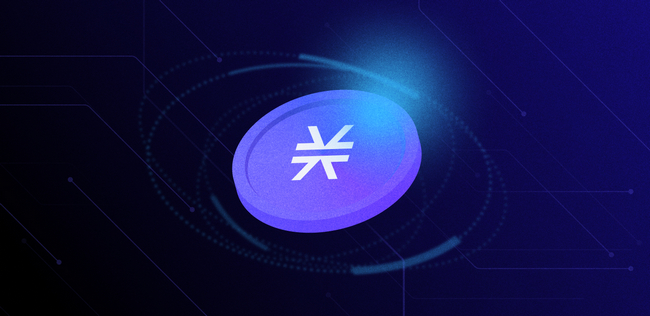-
 Bitcoin
Bitcoin $88,165.3830
4.45% -
 Ethereum
Ethereum $1,625.6684
3.15% -
 Tether USDt
Tether USDt $1.0003
0.03% -
 XRP
XRP $2.1145
3.08% -
 BNB
BNB $604.2805
2.78% -
 Solana
Solana $138.5597
1.63% -
 USDC
USDC $1.0000
0.01% -
 Dogecoin
Dogecoin $0.1611
5.18% -
 TRON
TRON $0.2438
-0.44% -
 Cardano
Cardano $0.6351
3.76% -
 Chainlink
Chainlink $13.3718
1.88% -
 Avalanche
Avalanche $20.6518
6.55% -
 UNUS SED LEO
UNUS SED LEO $9.1179
-2.25% -
 Stellar
Stellar $0.2584
6.98% -
 Toncoin
Toncoin $2.9759
-0.58% -
 Shiba Inu
Shiba Inu $0.0...01257
1.46% -
 Sui
Sui $2.2444
7.11% -
 Hedera
Hedera $0.1708
4.15% -
 Bitcoin Cash
Bitcoin Cash $345.2115
3.88% -
 Polkadot
Polkadot $3.8920
0.39% -
 Litecoin
Litecoin $79.7901
4.89% -
 Hyperliquid
Hyperliquid $18.0228
3.58% -
 Dai
Dai $0.9999
0.00% -
 Bitget Token
Bitget Token $4.4675
1.86% -
 Ethena USDe
Ethena USDe $0.9993
0.00% -
 Pi
Pi $0.6375
1.55% -
 Monero
Monero $214.7310
-1.32% -
 Uniswap
Uniswap $5.4128
3.57% -
 Pepe
Pepe $0.0...07912
5.87% -
 Aptos
Aptos $5.0623
1.32%
What can STX coin be used for? What is the future prospect of STX coin?
Stacks (STX) is a Layer-1 blockchain that enables smart contracts, decentralized applications, and financial services on the Bitcoin network.
Oct 04, 2024 at 05:05 pm

What is Stacks (STX)?
Stacks (STX) is a layer-1 blockchain that serves as a bridge between Bitcoin and decentralized applications (dApps). It enables the development of smart contracts and decentralized applications on the Bitcoin network.
Current Use Cases for STX Coin
1. Securitizing Bitcoin:
STX enables the creation of Bitcoin-backed assets called "Stacks Tokens," which can represent fractional ownership or derivatives of Bitcoin. These tokens allow users to access DeFi services without selling their Bitcoin holdings.
2. Smart Contract Functionality on Bitcoin:
Stacks extends the functionality of Bitcoin by enabling the deployment of smart contracts on its blockchain. This allows developers to build dApps that leverage the security and stability of Bitcoin.
3. Decentralized Finance (DeFi):
Stacks has an ecosystem of DeFi applications, including decentralized exchanges (DEXs), lending platforms, and more. These dApps enable users to perform financial activities such as trading, borrowing, and lending within the Stacks network.
4. Non-Fungible Tokens (NFTs):
Stacks allows the creation and trading of NFTs on its blockchain. These NFTs can represent digital collectibles, artwork, or other unique assets and provide a secure and immutable way to establish ownership and provenance.
Future Prospects of STX Coin
1. Increasing Adoption of DeFi on Stacks:
As DeFi continues to gain popularity, Stacks is well-positioned to benefit from increased adoption of its DeFi applications and services. This could drive demand for STX as more users seek ways to interact with DeFi on Bitcoin.
2. Cross-Chain Interoperability:
Stacks is actively exploring cross-chain interoperability solutions with other blockchains. This could allow STX to play a role in bridging different ecosystems and facilitating seamless asset transfer between them.
3. Expansion of Smart Contract Applications:
The Stacks ecosystem is continuously developing new smart contract applications and use cases. This growing utility could further enhance the value and demand for STX.
4. Improved Security and Scalability:
Stacks is actively working on improving the security and scalability of its blockchain, including upgrades to its consensus mechanism and enhancements to its Clarity smart contract language. These improvements could make the platform more attractive to developers and users.
5. Growing Community and Ecosystem:
The Stacks community and ecosystem are growing rapidly, with increasing developer interest and adoption of its applications. This could contribute to the future success and growth of STX.
Disclaimer:info@kdj.com
The information provided is not trading advice. kdj.com does not assume any responsibility for any investments made based on the information provided in this article. Cryptocurrencies are highly volatile and it is highly recommended that you invest with caution after thorough research!
If you believe that the content used on this website infringes your copyright, please contact us immediately (info@kdj.com) and we will delete it promptly.
- As the Crypto Market Evolves, XRP and Dogecoin Are Back in the Spotlight
- 2025-04-22 00:00:44
- Onchain social media platform Zora said its ZORA token will go live
- 2025-04-22 00:00:44
- Bitcoin Eyes $88,000 Breakout as Safe-Haven Narrative Gains Steam
- 2025-04-21 23:55:12
- As the Cryptocurrency Market Begins to Recover and Bitcoin Moves Closer to the $90,000 Mark, Investor Interest Is Gradually Returning
- 2025-04-21 23:55:12
- Blurring the Lines Between Decentralized Finance and Traditional Finance, Ripple's XRP Ledger (XRPL) Is at the Center of a New Attempt to Integrate Blockchain into the Heart of Institutional Trading
- 2025-04-21 23:50:13
- MicroStrategy Adds Another $555M Bitcoin Buy to Its Portfolio as BTC Trades Near $85K
- 2025-04-21 23:50:13
Related knowledge

What is Ethereum’s Slashing mechanism and how to punish malicious behavior?
Feb 20,2025 at 03:08am
Key PointsOverview of slashingDifferent types of slashing in EthereumIncentives and consequences of slashingIdentifying and reporting slashed validatorsOngoing discussions and potential improvementsEthereum's Slashing Mechanism: Punishing Malicious BehaviorEthereum's slashing mechanism is an essential tool for ensuring network security and punishing mal...

What is the verifier node of Ethereum and how to become a verifier?
Feb 19,2025 at 06:00pm
The Verifier Node of Ethereum: A Comprehensive GuideKey Points:What is a Verifier Node?How to Become a Verifier NodeResponsibilities and Rewards of a Verifier NodeMinimum Requirements for Becoming a Verifier NodePotential Difficulties in Running a Verifier Node1. What is a Verifier Node?A Verifier Node is an independent entity on the Ethereum network th...

What is Ethereum’s staking, and how to participate and earn money?
Feb 19,2025 at 04:37pm
Key Points:Understanding Ethereum's Staking MechanismSteps to Participate in StakingBenefits and Rewards of StakingSecurity and Risk ConsiderationsTechnical Requirements and Hardware OptionsPotential Challenges and Troubleshooting TipsFAQs on Ethereum StakingWhat is Ethereum's Staking?Proof-of-Stake (PoS) is a consensus mechanism used in blockchain netw...

What is Ethereum’s DAO (Decentralized Autonomous Organization) and how does it work?
Feb 20,2025 at 03:12am
Key PointsDefinition and Structure of a DAOGovernance and Decision-Making in DAOsBenefits and Use Cases of DAOsChallenges and Limitations of DAOsWhat is Ethereum's DAO (Decentralized Autonomous Organization) and How Does It Work?Definition and Structure of a DAOA Decentralized Autonomous Organization (DAO) is an innovative governance and management fram...

What is Ethereum's multi-signature wallet and how to improve security?
Feb 20,2025 at 02:18pm
Key Points:Understanding the Concept of a Multi-Signature WalletBenefits and Drawbacks of Multisig WalletsRequirements for Setting Up a Multisig WalletStep-by-Step Guide to Generating a Multisig WalletImplementing Strategies for Enhanced Security1. Understanding the Concept of a Multi-Signature WalletA multi-signature (multisig) wallet in the Ethereum e...

What is Ethereum's oracle and how to provide data for smart contracts?
Feb 21,2025 at 01:30am
Key Points:Understanding the concept of oracles in EthereumExploring different types of oraclesDetailed guide on how to provide data for smart contractsAddressing potential challenges and considerationsWhat is Ethereum's Oracle?Oracles are crucial components in the Ethereum ecosystem, enabling smart contracts to access real-world data and off-chain even...

What is Ethereum’s Slashing mechanism and how to punish malicious behavior?
Feb 20,2025 at 03:08am
Key PointsOverview of slashingDifferent types of slashing in EthereumIncentives and consequences of slashingIdentifying and reporting slashed validatorsOngoing discussions and potential improvementsEthereum's Slashing Mechanism: Punishing Malicious BehaviorEthereum's slashing mechanism is an essential tool for ensuring network security and punishing mal...

What is the verifier node of Ethereum and how to become a verifier?
Feb 19,2025 at 06:00pm
The Verifier Node of Ethereum: A Comprehensive GuideKey Points:What is a Verifier Node?How to Become a Verifier NodeResponsibilities and Rewards of a Verifier NodeMinimum Requirements for Becoming a Verifier NodePotential Difficulties in Running a Verifier Node1. What is a Verifier Node?A Verifier Node is an independent entity on the Ethereum network th...

What is Ethereum’s staking, and how to participate and earn money?
Feb 19,2025 at 04:37pm
Key Points:Understanding Ethereum's Staking MechanismSteps to Participate in StakingBenefits and Rewards of StakingSecurity and Risk ConsiderationsTechnical Requirements and Hardware OptionsPotential Challenges and Troubleshooting TipsFAQs on Ethereum StakingWhat is Ethereum's Staking?Proof-of-Stake (PoS) is a consensus mechanism used in blockchain netw...

What is Ethereum’s DAO (Decentralized Autonomous Organization) and how does it work?
Feb 20,2025 at 03:12am
Key PointsDefinition and Structure of a DAOGovernance and Decision-Making in DAOsBenefits and Use Cases of DAOsChallenges and Limitations of DAOsWhat is Ethereum's DAO (Decentralized Autonomous Organization) and How Does It Work?Definition and Structure of a DAOA Decentralized Autonomous Organization (DAO) is an innovative governance and management fram...

What is Ethereum's multi-signature wallet and how to improve security?
Feb 20,2025 at 02:18pm
Key Points:Understanding the Concept of a Multi-Signature WalletBenefits and Drawbacks of Multisig WalletsRequirements for Setting Up a Multisig WalletStep-by-Step Guide to Generating a Multisig WalletImplementing Strategies for Enhanced Security1. Understanding the Concept of a Multi-Signature WalletA multi-signature (multisig) wallet in the Ethereum e...

What is Ethereum's oracle and how to provide data for smart contracts?
Feb 21,2025 at 01:30am
Key Points:Understanding the concept of oracles in EthereumExploring different types of oraclesDetailed guide on how to provide data for smart contractsAddressing potential challenges and considerationsWhat is Ethereum's Oracle?Oracles are crucial components in the Ethereum ecosystem, enabling smart contracts to access real-world data and off-chain even...
See all articles






















































































